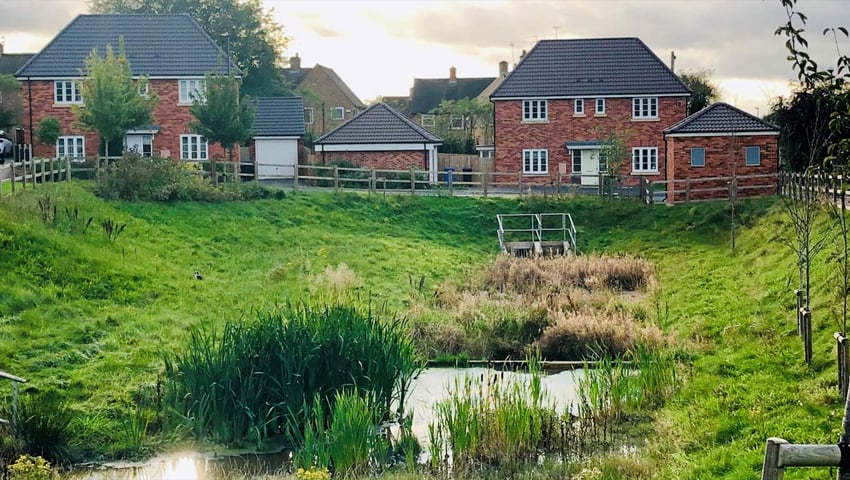In a move to tackle water pollution and protect communities from flooding, the government is updating the national standards for Sustainable Drainage Systems (SuDS) for the first time in a decade.
The new standards – welcomed by the construction industry – will give developers clearer guidance on how to create rainwater management systems that mimic the natural environment and deliver better outcomes.
Suggested features include spaces designed to collect and filter rainwater, which will relieve pressure on our crumbling sewage system and prevent pollution overflowing into our waterways.
Impermeable surfaces such as roads and pavements increase the risk of flooding in heavy downpours, as the excess water has nowhere to go. By introducing materials designed to soak up water, new developments will be better protected against flooding.
The new standards will also encourage design features like green roofs and soakaways. These provide a place for nature to thrive and improve a building’s energy efficiency –reducing energy bills, bringing mental and physical health benefits to communities by expanding access to nature and supporting wildlife.
Dr Gabriel Connor-Streich, CEO of Greenshank Environmental, said, “This is a welcome move that looks like a further step towards implementation of Schedule 3 of the Flood and Water Management Act. That the standards cover more than just controlling runoff rates is critical to promoting multiple benefits from good SuDS design. However, this approach to promoting multiple benefits through SuDS design has been baked into guidance on SuDS for over a decade (via the SuDS Handbook and subsequent guidance documents).
“We also need a system – which I assume will come via SuDS Approval Bodies – that means if you don’t comply with the new national standards you can’t build. At present this is still missing, so while the standards may provide a consistent means of achieving good SuDS designs, whether there will be a need to do this above the current approach, which primarily focusses on runoff rate control, is to be confirmed. My crystal ball is also suggesting these standards may in someway feed into the Nature Restoration Fund and levies for nutrient mitigation that are likely to fall out of the Planning and Infrastructure Bill.”
The Rivers Trust has welcomed the new national standards. Their spokesperson said that, “Sustainable drainage systems are a fantastic way to tackle the multiple challenges facing our towns and cities. When implemented to a high standard, SuDS turn our cities into green oases that act as sponges to hold onto water and allow it to gradually replenish our natural underground storage areas. This plays a crucial role in mitigating both flood and drought risk, reducing water pollution, supporting biodiversity, and supporting healthy, happy communities with access to high quality green and blue space that also keep neighbourhoods cool in our changing climate.
“Despite this positive news, we have been waiting since 2010 for SUDS to be made mandatory for all new developments, as per the Flood and Water Management Act. It’s great to have new standards but, as the government embarks upon its ambitious plan for growth, these should be applied across the board in new housing or industrial developments, retrofitted in existing ones, and as part of public maintenance work.”
Mark Lloyd, Chief Executive of The Rivers Trust, said, “It’s really great to see these new standards published, but we now need to see developers required to implement sustainable drainage systems, as standard, on every new development. We need to build resilience to drought and floods, restore wildlife habitats and reduce the pressure on the sewerage system from surface water and these systems are a fantastic way to do all those things and more.”
Key features of the new standards include:
- Reducing flood risk by actively managing surface water on site
- Improving water quality before it enters rivers and streams
- Provide community benefits by creating more attractive and resilient places to live and work
- Prioritising solutions that enhance biodiversity and green space
- Encouraging water efficiency, by enabling the reuse of rainwater through harvesting and collection systems
- Emphasising long-term maintenance and performance
